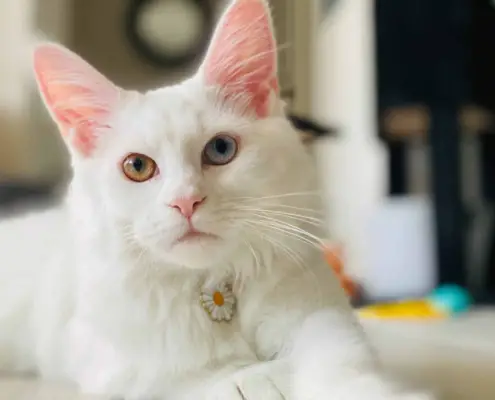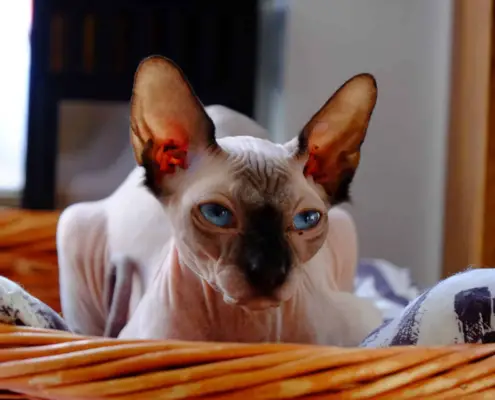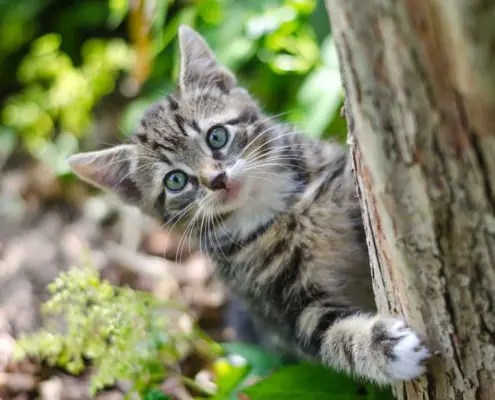
When it comes to animals with fascinating eyes, cats definitely take the spotlight. Their eyes are not only captivating but also possess a unique structure that sets them apart from other animals. In this article, we will delve into the intricate anatomy of a cat’s eye, explore the purpose of each of their eyelids, understand their eye movements, learn about common eye conditions, and appreciate the evolutionary advantages of their eyelid structure. By the end of this article, you will have a deeper understanding of the beauty and functionality of cat eyes.
The Anatomy of a Cat’s Eye
A cat’s eye is a marvel of nature, designed to provide them with exceptional vision. The structure of their eyes is similar to that of other mammals, but with a few key differences. The first layer is the cornea, a transparent dome-shaped tissue that protects the eye and helps to focus light. Behind the cornea is the iris, which gives cats their unique eye colors and controls the amount of light entering the eye through the pupil. The lens, located behind the iris, further focuses the light onto the retina, a layer of cells at the back of the eye that processes visual information.
How Many Eyelids Do Cats Have?
Unlike humans who have only two eyelids, cats have an additional third eyelid, called the haw. The haw is a thin, translucent membrane that rests in the inner corner of the eye. Its purpose is to provide extra protection for the eye, acting as a barrier against foreign objects, dust, and debris. The haw also helps to distribute tears across the surface of the eye, keeping it moist and preventing dryness.
The Purpose of Each Eyelid in Feline Vision
Each of the cat’s eyelids serves a specific purpose in feline vision. The upper eyelid functions similar to that of humans, covering the eye when closed and protecting it from external elements. The lower eyelid complements the upper eyelid, helping to keep the eye moist and clean. The haw, the third eyelid, acts as an additional protective layer, especially during hunting or other activities that may expose the eye to potential harm.
Blinking and Winking: Understanding Cat Eye Movements
Cat eye movements are a fascinating aspect of their eye anatomy. When cats blink, their upper and lower eyelids come together, much like humans. However, cats also have the ability to close their eyes partially, creating a narrow opening. This is known as a “cat’s wink” and is often seen when they are relaxed or content. The wink is a way for cats to signal trust and affection. Additionally, cats have a rapid blinking reflex that helps moisten their eyes and keep them clean.
Cat Eye Health and Common Eye Conditions
Maintaining good eye health is crucial for the overall well-being of cats. While cats are generally known for their excellent vision, they are still susceptible to various eye conditions. Some common eye conditions in cats include conjunctivitis, corneal ulcers, glaucoma, and cataracts. Regular check-ups with a veterinarian, proper nutrition, and a clean environment can help prevent these conditions and ensure optimal eye health for your feline companion.
How Cat Eyelids Contribute to a Cat’s Hunting Abilities
A cat’s eyelid structure plays a significant role in their hunting abilities. The combination of their large pupils and the ability to control the amount of light entering the eye allows cats to have excellent night vision. The haw, or third eyelid, acts as a natural “sunglasses” by filtering excess light, enhancing their ability to see in low-light conditions. This unique feature gives cats a distinct advantage when it comes to hunting prey in dimly lit environments.
Evolutionary Advantages of a Cat’s Eyelid Structure
The evolution of a cat’s eyelid structure has provided them with several advantages. The ability to partially close their eyes helps protect their eyes from bright sunlight, dust, and debris while maintaining their peripheral vision. The haw, or third eyelid, serves as an extra layer of protection against potential injuries during hunting or other activities. Additionally, the combination of their large pupils and the ability to quickly adjust the size of their iris allows cats to adapt to different lighting conditions, giving them a competitive edge in their natural habitat.
Caring for Your Cat’s Eyes: Tips for Maintaining Healthy Vision
Taking care of your cat’s eyes is vital for their overall health and well-being. Here are some tips to help maintain healthy vision for your feline companion:
- Regularly clean their eyes with a soft, damp cloth to remove any discharge or debris.
- Ensure their living environment is clean and free from irritants.
- Schedule regular veterinary check-ups to monitor their eye health.
- Provide a nutritionally balanced diet to support their eye health.
- Avoid using harsh chemicals or products near their eyes.
- Be observant of any changes in their eye appearance or behavior and consult a veterinarian if necessary.
Appreciating the Beauty and Functionality of Cat Eyes
Cat eyes are truly remarkable, both in their beauty and functionality. Their unique eyelid structure, with the addition of the haw, provides them with enhanced protection and vision capabilities. Understanding the anatomy and purpose of each eyelid allows us to appreciate the intricate design of their eyes. By taking proper care of our feline companions’ eyes, we can ensure their vision remains healthy and vibrant for years to come. So, next time you look into your cat’s eyes, take a moment to marvel at the wonders of nature that lie within them.
Remember, a happy and healthy cat starts with proper care and attention.
If you enjoyed my article, I would appreciate you sharing it with your network.

Sima Ndlebe
Sima writes for CatBuzz. He is interested in Cats, Health and Fitness, and Entrepreneurship.
Published: 1 November 2023



